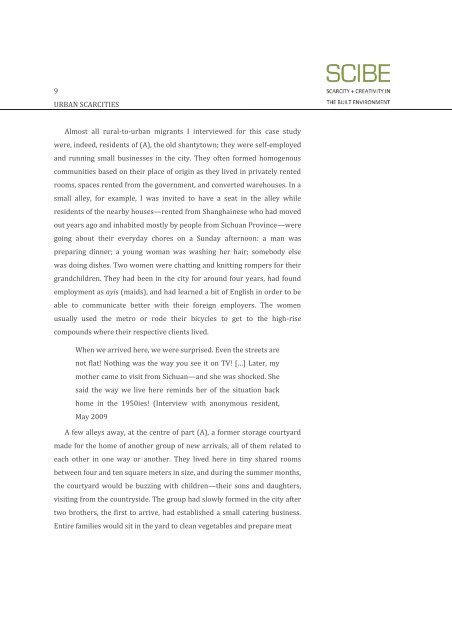Urban Scarcities: A Look at Shanghai - SCIBE
Urban Scarcities: A Look at Shanghai - SCIBE
Urban Scarcities: A Look at Shanghai - SCIBE
Create successful ePaper yourself
Turn your PDF publications into a flip-book with our unique Google optimized e-Paper software.
9<br />
URBAN SCARCITIES<br />
Almost all rural-to-urban migrants I interviewed for this case study<br />
were, indeed, residents of (A), the old shantytown; they were self-employed<br />
and running small businesses in the city. They often formed homogenous<br />
communities based on their place of origin as they lived in priv<strong>at</strong>ely rented<br />
rooms, spaces rented from the government, and converted warehouses. In a<br />
small alley, for example, I was invited to have a se<strong>at</strong> in the alley while<br />
residents of the nearby houses—rented from <strong>Shanghai</strong>nese who had moved<br />
out years ago and inhabited mostly by people from Sichuan Province—were<br />
going about their everyday chores on a Sunday afternoon: a man was<br />
preparing dinner; a young woman was washing her hair; somebody else<br />
was doing dishes. Two women were ch<strong>at</strong>ting and knitting rompers for their<br />
grandchildren. They had been in the city for around four years, had found<br />
employment as ayis (maids), and had learned a bit of English in order to be<br />
able to communic<strong>at</strong>e better with their foreign employers. The women<br />
usually used the metro or rode their bicycles to get to the high-rise<br />
compounds where their respective clients lived.<br />
When we arrived here, we were surprised. Even the streets are<br />
not fl<strong>at</strong>! Nothing was the way you see it on TV! […] L<strong>at</strong>er, my<br />
mother came to visit from Sichuan—and she was shocked. She<br />
said the way we live here reminds her of the situ<strong>at</strong>ion back<br />
home in the 1950ies! (Interview with anonymous resident,<br />
May 2009<br />
A few alleys away, <strong>at</strong> the centre of part (A), a former storage courtyard<br />
made for the home of another group of new arrivals, all of them rel<strong>at</strong>ed to<br />
each other in one way or another. They lived here in tiny shared rooms<br />
between four and ten square meters in size, and during the summer months,<br />
the courtyard would be buzzing with children—their sons and daughters,<br />
visiting from the countryside. The group had slowly formed in the city after<br />
two brothers, the first to arrive, had established a small c<strong>at</strong>ering business.<br />
Entire families would sit in the yard to clean vegetables and prepare me<strong>at</strong>




